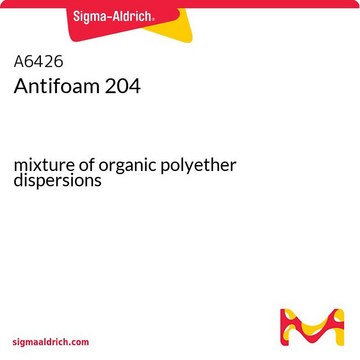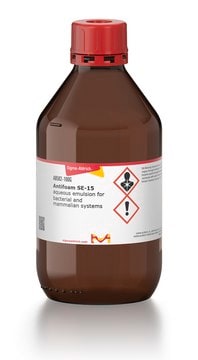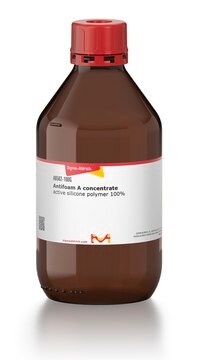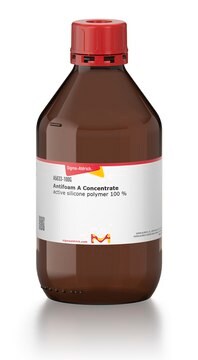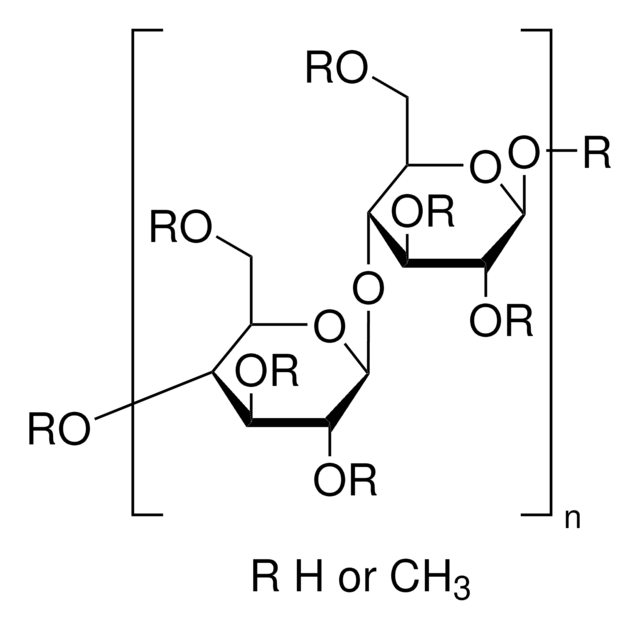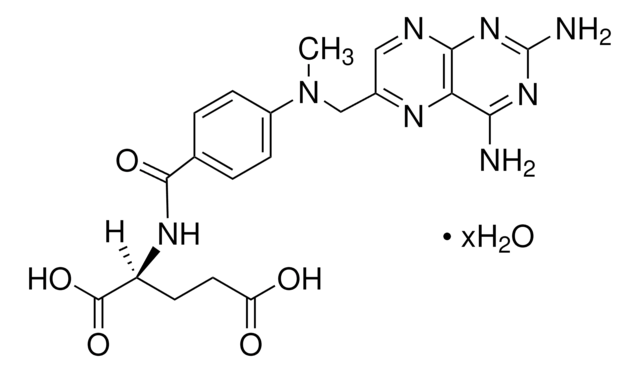Wszystkie zdjęcia(1)
Kluczowe dokumenty
A8011
Antifoam C Emulsion
aqueous-silicone emulsion
Synonim(y):
Antifoaming Agent Emulsion
Zaloguj sięWyświetlanie cen organizacyjnych i kontraktowych
About This Item
Kod UNSPSC:
12161900
NACRES:
NA.25
Polecane produkty
pochodzenie biologiczne
synthetic
Poziom jakości
Formularz
emulsion
zawiera
emulsifier
metody
cell culture | hybridoma: suitable
microbiological culture: suitable
mp
0 °C (32 °F)
Powiązane kategorie
Opis ogólny
Antifoam C emulsion is an aqueous emulsion containing 30% active silicone. This silicone-based antifoam emulsion consists of non-ionic emulsifiers different from those in antifoam emulsions B and Y-30. Antifoam C emulsion can be prediluted with 3-10 parts of cool water to aid in dispersion. Prediluted suspensions should be used immediately. Antifoam C emulsion is typically effective at 1-10 ppm. The flow properties of antifoam C emulsion are such that it can be pumped on an as-needed basis to a fermenter system with sufficient agitation to disperse the antifoam. Antifoam C emulsion can be used to regulate headspace foaming in mammalian cell culture bioreactors up to 30 ppm concentration.
Zastosowanie
Antifoam C emulsion has been used:
- as a supplement in RO-H2O and a chemically defined culture medium to determine volumetric mass transfer coefficient (kLa) of mammalian cell culture
- as a component of feed medium,
- as a steam-sterilized antifoaming agent in a biocontroller for pH-stat fed-batch cultivations
- as a supplement in fed batch medium to mimic the typical large-scale cultivation conditions
Cechy i korzyści
- Minimizes compatibility issues with biological systems
- Highly effective defoamer at low concentrations
- Highly effective and versatile silicone defoamer
Inne uwagi
A 30% aqueous emulsion of polydimethylsiloxane concentrate.
For additional information on our range of Biochemicals, please complete this form.
Ta strona może zawierać tekst przetłumaczony maszynowo.
Hasło ostrzegawcze
Warning
Zwroty wskazujące rodzaj zagrożenia
Zwroty wskazujące środki ostrożności
Klasyfikacja zagrożeń
Eye Irrit. 2 - STOT SE 3
Organy docelowe
Respiratory system
Kod klasy składowania
10 - Combustible liquids
Klasa zagrożenia wodnego (WGK)
WGK 3
Temperatura zapłonu (°F)
Not applicable
Temperatura zapłonu (°C)
Not applicable
Środki ochrony indywidualnej
Eyeshields, Gloves, type ABEK (EN14387) respirator filter
Wybierz jedną z najnowszych wersji:
Masz już ten produkt?
Dokumenty związane z niedawno zakupionymi produktami zostały zamieszczone w Bibliotece dokumentów.
Klienci oglądali również te produkty
Bernhard Sissolak et al.
Biotechnology journal, 14(7), e1800714-e1800714 (2019-04-16)
Frequently measured mammalian cell culture process indicators include viability and total cell concentration (TCC). Cell lysis, an additional important process characteristic that substantially contributes to the overall product purity profiles, is often not addressed in detail. In the present study
Gang Fu et al.
Biotechnology and applied biochemistry, 67(5), 812-818 (2019-10-08)
d-Psicose 3-epimerase is an enzyme that catalyzes the synthesis of d-psicose from d-fructose. We cloned the d-psicose 3-epimerase from Ruminococcus sp. (RDPE) and expressed it in Bacillus subtilis A311. By a two-step pH regulation of segmented fermentation, we significantly improved
Characterizing the Effects of Antifoam C Emulsion on Oxygen Mass Transfer within the BIOne Drilled-Hole Sparger and Microsparger Single-Use Bioreactor Systems
McAndrew J and Kauffman G
American Pharmacy null
Mervyn W O Liew et al.
Journal of biotechnology, 150(2), 224-231 (2010-08-28)
This study demonstrates the feasibility of large-scale production of murine polyomavirus VP1 protein in recombinant Escherichia coli as pentamers which are able to subsequently self-assemble in vitro into virus-like particles (VLPs). High-cell-density pH-stat fed-batch cultivation was employed to produce glutathione-S-transferase
Bernhard Sissolak et al.
Journal of industrial microbiology & biotechnology, 46(8), 1167-1178 (2019-06-09)
Recombinant monoclonal antibodies are predominantly produced in mammalian cell culture bioprocesses. Post-translational modifications affect the micro-heterogeneity of the product and thereby influence important quality attributes, such as stability, solubility, pharmacodynamics and pharmacokinetics. The analysis of the surface charge distribution of
Nasz zespół naukowców ma doświadczenie we wszystkich obszarach badań, w tym w naukach przyrodniczych, materiałoznawstwie, syntezie chemicznej, chromatografii, analityce i wielu innych dziedzinach.
Skontaktuj się z zespołem ds. pomocy technicznej